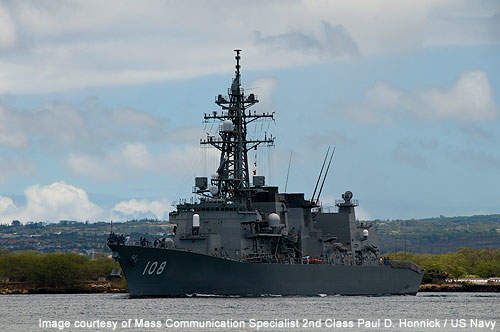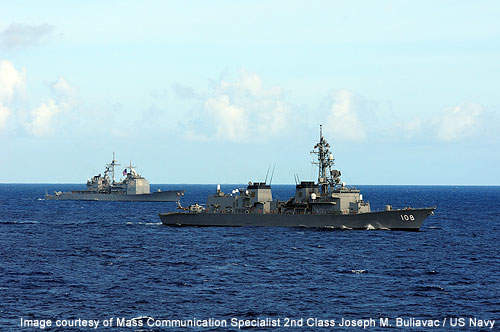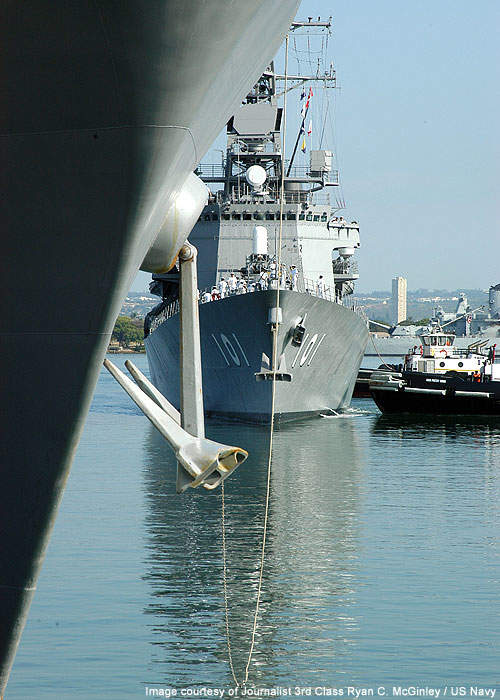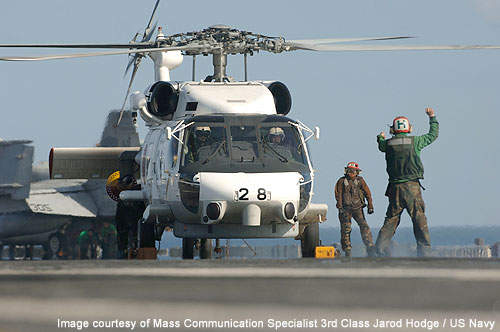The Murasame Class guided-missile destroyers are third-generation multi-purpose ships of the Japan Maritime Self Defence Force (JMSDF). Nine destroyers have been jointly built by the IHI Tokyo Shipyard and Marine United (MU). Murasame is preceded by the Asagiri Class destroyers and succeeded by the Takanami Class.
The Murasame Class can conduct anti-submarine warfare (ASW) and anti-surface warfare (ASuW) missions and features some limited defence capabilities against airborne threats.
The keel for the lead ship in the class, Murasame (DD 101), was laid down in August 1993. It was launched in August 1994 and commissioned in March 1996. Harusame (DD 102) was laid in August 1994, launched in October 1995 and commissioned in March 1997. Yudachi (DD 103) was laid in March 1996, launched in August 1997 and commissioned in March 1999. Kirisame (DD 104) was laid in April 1996, launched in August 1997 and commissioned in March 1999.
Inazuma (DD 105) was laid in May 1997, launched in September 1998 and commissioned in March 2000. Samidare (DD 106) was laid in September 1997, launched in September 1998 and commissioned in March 2000. Ikazuchi (DD 107) was laid in February 1998, launched in June 1999 and commissioned in March 2001. Akebono (DD 108) was laid in October 1999, launched in September 2000 and commissioned in March 2002. The final ship in its class, Ariake (DD 109), was laid down in May 1999, launched in October 2000 and commissioned in March 2002.
Murasame design
The destroyer has an enlarged hull. Its stealth characteristics ensure greater survivability. The superstructure and hull are angled instead of traditional vertical surfaces.
The Murasame destroyer lacks the angled tripod main mast found on the Arleigh Burke class destroyer as it operates on the Sea of Japan under rigid winter weather conditions. Onboard systems are automated wherever possible.
Command and control
The Murasame Class is equipped with the new-generation C4I system integrating the OYQ-9 CDS (combat direction system) and the OYQ-103 ASW control system. The OYQ-9 CDS includes AN/UYK-43, AN/UYK-44 and AN/UYQ-21 workstations. The OYQ-103 and associated sub-systems are considered the Japanese equivalent to the US-made AN/SQQ-89 ASW combat system.
Murasame missiles
The Murasame Class destroyers are armed with an Mk48 VLS (vertical launching system) firing Sea Sparrow and Evolved Sea Sparrow surface-to-air missiles. The Mk41 VLS installed below the deck can fire RUM-139 VL ASROC (anti-submarine rockets).
The original configuration of the two VLS modules on each ship were replaced by four modules consisting of eight cells each. The Japanese made SSM-1B ship-to-ship missile onboard engages targets within a range of 150km-200km.
Naval guns
The main gun fitted forward is an Oto Melara 3 (now Oto Breda) 76mm, 62 calibre, rapid fire gun.
The gun can fire 120 rounds a minute at a range of 30km.
Two Mark 15 20mm Phalanx CIWS (close-in weapon system), one mounted at the forward of the bridge and the other over the helicopter hangar, are used for point-defence against incoming anti-ship missiles and low flying aircraft.
Torpedoes
Six 324mm, Type 68 torpedo tubes are configured in two triples. The tubes can launch Mk46 Mod 5 anti-submarine torpedoes. The Mk46 Mod 5 can strike the submarines in a water depth of 365m within an 11km range.
Sensors / radars
The sensor suite includes an OPS-24 active air search radar, OPS-20 navigation radar and OPS-28-D surface search and target acquisition radar. The vessel is also equipped with a NOLQ-3 intercept or jammer, an OQE-1 towed array sonar and an OQS-5 hull mounted sonar.
Aircraft
The Murasame Class has an aft landing deck and hangar to support the operations of a single SH-60J ASW helicopter intended for an anti-submarine patrol role. The vessels are also equipped with helicopter maintenance facilities.
Propulsion
The Murasame class is powered by a combined gas turbine and gas turbine (COGAG) propulsion system. Two General Electric LM2500 boost gas turbines and two Rolls-Royce Sprey SM1C cruise gas turbines deliver a total power output of 60,000ps. The propulsion system provides a maximum speed of 30kt and a range of 8,350km at a cruising speed of 18kt.







